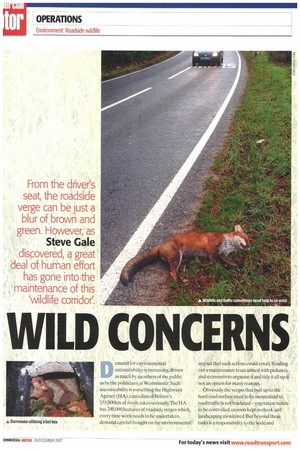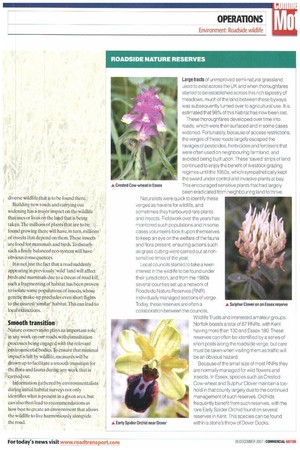WILD CONCERNS
Page 62

Page 63

If you've noticed an error in this article please click here to report it so we can fix it.
From the driver's seat, the roadside verge can be just a blur of brown and green. However, as Steve Gale discovered, a great deal of human effort has gone into the maintenance of this 'wildlife corridor'.
Demand for environmental accountability is increasing, driven as much by members of the public as by the politicians at Westminster. Such accountability is something the Highways Agency (HA),custodian of Britain's 155,000km of roads, takes seriously.The HA has 200,000 hectares of roadside verges which, every time work needs to be undertaken, demand careful thought on the environmental impact that such actions could entail. Sending out a maintenance team armed with pickaxes and strirnmers to organise it and tidy it all up is not an option for many reasons.
Obviously the verges that butt up to the hard road surface need to be maintained so road traffic is not hindered— vegetation needs to be controlled, erosion kept in check and landscaping monitored. But beyond these tasks is a responsibility to the wide and diverse wildlife that is to be found there.
uilding new roads and carrying out wid ning has a major impact on the wildlife tha uses or lives on the land that is being taken.The millions of plants that are to be found growing there Will have, in turn, millions of insects that depend on them:These insects are food for mammals and birds.To disturb such a finely balanced eco-system will have obvious consequences.
It, is not just the fact that a road suddenly appearing in previously 'wild' land will affect birds and mammals due to a threat of road kill, such a fragmenting of habitat has been proven to isolate some populations of insects, whose genetic make-up precludes even short flights to the nearest 'similar' habitat.This can lead to local extinctions.
Smooth transition
Nature conservation plays an important role in any work on our roads.with consultation processes being engaged with the relevant environmental bodies.To ensure that minimal i in pact is felt by wildlife, measures will be drawn up to facilitate a smooth transition for the flora and fauna during any work that is carried out.
Information gathered by environmentalists 71 du ' g initial habitat surveys not only ide tifies what is present in a given area, but can also then lead to recommendations as how best to create an environment that allows the wildlife to live harmoniously, alongside the road.
































































































































































































